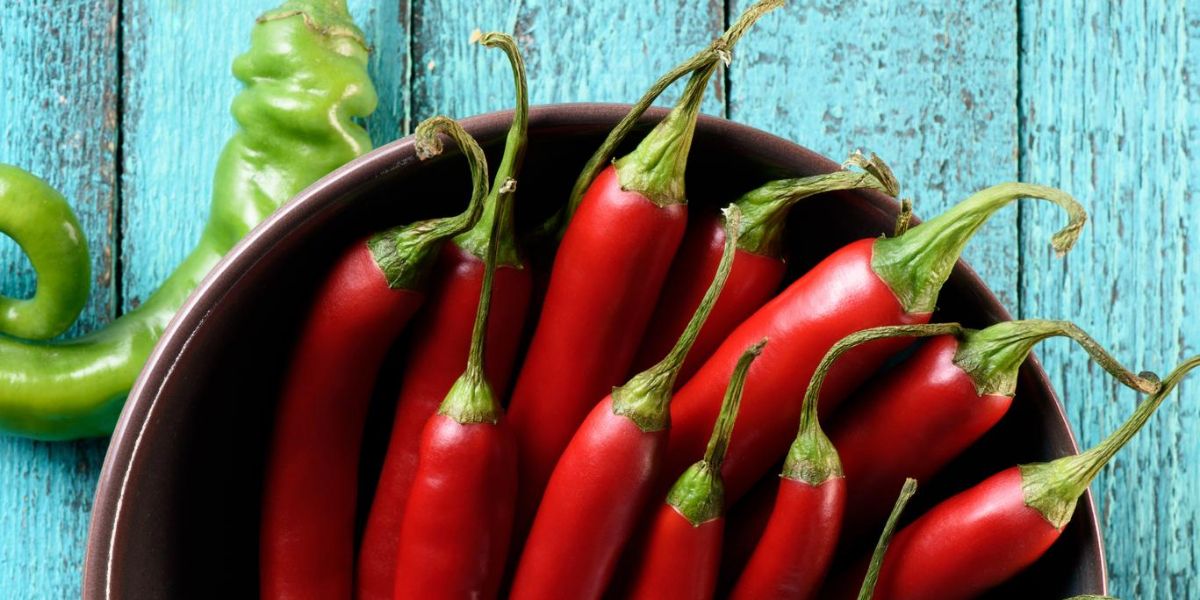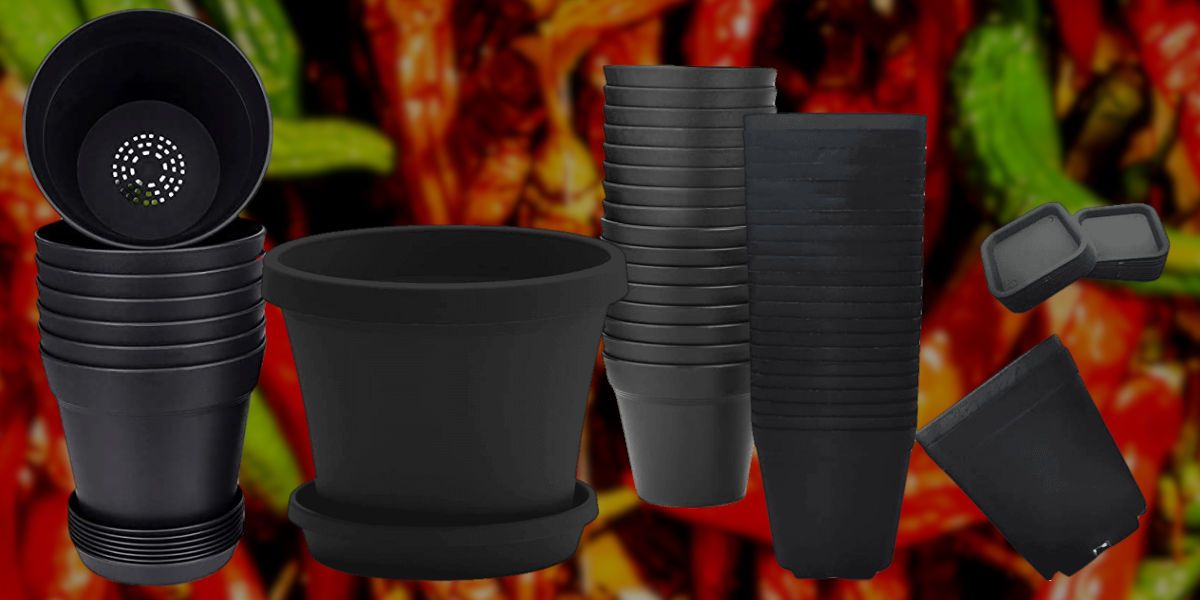What Are Chili Peppers Or Hot Peppers?

Chili pepper plants are members of the nightshade family, just like tomato plants. They carry fruit, also known as chili peppers or hot peppers. These fruits are well known for their spiciness and are therefore often used in spicy dishes worldwide.
There are five species of chili pepper plants and many varieties in each of these species. The best-known hot peppers are Cayenne, Serrano, Jalapeño, and Tabasco, among others.
Are you a chili pepper lover who wants to learn how to grow chili pepper plants at home? Look no further! Click below to find out which must-have books will guide you through the process of growing your own chili peppers...
The chemical known as capsaicin is what causes the heat when eating a chili pepper. This chemical is harmless by itself and does not burn your skin. Capsaicin essentially binds temporarily to the pain receptors in your skin and the heat receptors on your tongue.
A measure called the Scoville Heat Unit exists to determine the heat of chilies - also abbreviated as SHU. The higher the SHU, the hotter the pepper. The hottest chili pepper currently known is Pepper X.
In this article, I explore what chili peppers are, and I also discuss various aspects related to them, like the hotness and what causes this.
Table of Contents
What are chili peppers?
Chili peppers can refer to both the plants and the fruits from the plants.
Chili pepper plants are members of the genus Capsicum, which in its turn is part of the nightshade plant family. The nightshades are also referred to as Solanaceae in Latin.
Tomato plants are also well-known members of the nightshade family. This can be handy to know as the chili pepper plants and the tomato plants make excellent companion plants.
The fruits of the chili pepper plants are also referred to as chili peppers or hot peppers. These fruits are well known for their heat when ingested. For this reason, chilies are used as a spice for many different spicy dishes.
In chili fruits, there is a chemical called capsaicin that causes a sensation of heat in the mouth and potentially on other parts of the body - especially mucous membranes.
When preparing chili pepper fruits for a dish, you, therefore, need to be careful when touching them. A piece of standard advice is to wear gloves and even something to cover your mouth and nose.
Apart from the chili pepper plants, bell pepper plants, aka sweet peppers, are also a member of the Capsicum genus. Bell peppers, in contrast to chili peppers, have no heat at all.
Chili plants exist in various sizes - from 60cm to several meters. The actual height a chili plant reaches depends on the variety that is grown and also on the growing conditions.
Chili fruits also exist in various shapes and colors.
In addition to their spiciness, peppers also have a wide range of flavors like smoky flavor and citrus flavor.
Chili peppers seem to have originated in Mexico or Brazil. These plants belong to some of the earliest cultivated crops in this region of the world. From there, they were first introduced to Central America and South America. Later, when Columbus reached America, the plants were spread to other parts of the world, as the chilies were regarded as valuable spices.
Some of the most popular peppers are Cayenne, Serrano, Jalapeño (known as Chipotle pepper when dried), Tabasco, Habanero, Cherry peppers.
Chili Species and Varieties
As of 2021, there are five known chili pepper species and a multitude of hot pepper varieties.
| Species | Varieties |
| Capsicum Annuum | Bell pepper, Jalapeño, Serrano, Cayenne, Big Jim, Anaheim, Yellow Wax pepper (Banana peppers) |
| Capsicum Pubescens | Rocoto, Manzano |
| Capsicum Frutescens | Cabai Rawit, Hawaiian pepper, Malagueta pepper, Piri Piri, Tabasco pepper, Thai Chili peppers |
| Capsicum Chinense | Aji Dulce, Fatalii, Habanero, Scotch Bonnet, Trinidad Scorpion, Ajoema |
| Capsicum Baccatum | Aji Amarillo, Lemon Drop, Bishop's Crown |
A few researchers from India claim to have determined an additional species that they call Capsicum Assamicum. This species has a mix of properties of Capsicum Frutescens and Capsicum Chinense. If their assertion is correct, then the pepper known as the Ghost Pepper or Bhut Jolokia should be classified under this species.
What makes peppers spicy?
The chemical that makes chilies hot is called capsaicin. When any bodily tissue gets in contact with the chemical, it produces a kind of burning or hot sensation.
In the pepper plants, capsaicin and a couple of related chemicals are believed to work as a kind of repellant against some mammals and fungi. Birds, on the other hand, do not feel any burning sensation. It seems that the plants have evolved to make birds eat and subsequently disperse the chili seeds.
The chemical is mainly present in the tissue in the chili plants that holds the seeds. It can also be found in smaller quantities in the fleshy parts of the chili fruits.
Capsaicin does not actually burn you. Instead, it binds to the pain receptors in the tissue which it touches. The pain receptors in the tongue are especially sensitive to the chemical, given that the tongue has a lot of nerve endings. The receptors on the tongue that detect heat can also be bound by capsaicin, which is why ingesting a chili pepper feels hot.
Ingesting a large amount of capsaicin is not dangerous by itself. Yet, the intense burning sensation that the chemical causes in the nervous system can result in stomach pain, spasms, cramps, vomiting, etc.
The body will believe that a part of you is burning and will try to cool you down. This is why you start to sweat when eating spicy food in general. Your breathing rate may also increase for this reason. The production of tears, mucus, and saliva will increase because your body believes it can flush out the burning substance.
Relieving the burn with water will not help. In fact, it may make it feel much worse as the water may simply spread the capsaicin around.
The only way to get rid of the burning sensation is to drink milk or to eat yogurt or a piece of bread with peanut butter. The reason being that the chemical dissolves in oils and fats. Capsaicin can also dissolve in alcohol, but that is not recommended as a pain reliever.
The capsaicin chemical will become neutralized after a while, and hence the burning feeling will disappear at some point.
People with irritable bowel syndrome, Crohn's disease, and other bowel-related diseases should be careful when eating hot peppers. The effects of capsaicin may worsen the symptoms.
From all this, you can probably already guess that the amount of heat you feel when eating spicy peppers depends on the amount of capsaicin present in the fruit. The hotter the burning sensation when eating a chili pepper, the more capsaicin is in the pepper.
Likewise, Bell peppers do not contain any capsaicin. The result is that Bell peppers have no heat at all.
What is the scale of hot peppers?
To measure the heat of chili peppers, a measuring unit was created by the American pharmacist Wilbur Scoville in 1912. Since then, this unit has been called the Scoville Heat Unit (SHU). The SHU measure is based on the concentration of capsaicin molecules (and related chemicals) present in a given fruit.
Initially, the Scoville Heat Units were measured subjectively using a panel of five human testers. They would be given a solution of dried pepper in alcohol that was further diluted with sugar water. The alcohol was used to extract the active capsaicin components. The concentrations would then be diluted until a majority of the tasters in the panel could no longer feel the heat. The SHU is thus a multiple based on the number of dilutions.
This subjective test was used for a long time, but it has some obvious disadvantages. The human testers would have to rely on their burn sensations, but these can vary significantly from person to person. In addition, as a test progresses, a kind of sensory fatigue can be experienced that further influences subjectivity.
The results from the subjective test could vary 50% from one testing lab to another.
Currently, an objective quantitative test is used. With this test, the actual concentration of capsaicin and related chemicals is measured in a lab. This measurement can then be converted into the original Scoville Heat Units. So nowadays, the SHU is a measure that can be determined precisely in a laboratory.
Hence, this is a scale that starts with 0 for peppers with no heat at all. Technically you could say that Bell peppers have a heat of 0 SHU. As the heat of the chili fruits increases, the scale also increases.
What are some of the top hottest peppers?
The hot peppers listed below are the hottest in early 2021, but this will likely change over time as several growers are continuously trying to breed even hotter varieties.
The hottest pepper is currently Pepper X, although the listed Scoville Heat Units for this chili are unconfirmed.
| Chili Pepper Variety | Scoville Heat Units |
| Pepper X | ~ 3.180.000 SHU |
| Dragon's Breath | ~ 2.480.000 SHU |
| Carolina Reaper | ~ 2.400.000 SHU |
| 7Pot Douglah | ~ 1.853.936 SHU |
| 7 Pot Primo | ~ 1.469.000 SHU |
| Trinidad Scorpion “Butch T” | ~ 1.463.700 SHU |
| Naga Viper | ~ 1.382.000 SHU |
| Trinidad Moruga Scorpion | ~ 1.200.000 SHU |
| Ghost Pepper (Bhut Jolokia, Naga Jolokia) | ~ 1.041.427 SHU |
| Naga Morich | ~ 1.000.000 SHU |
| Infinity Chili | ~ 1.000.000 SHU |
| 7 Pot Barrackpore | ~ 1.000.000 SHU |
| 7 Pot Red (Giant) | ~ 1.000.000 SHU |
| Red Savina Habanero | ~ 500.000 SHU |
| Chocolate Habanero | ~ 500.000 SHU |
References
- https://en.wikipedia.org/wiki/Chili_pepper
- https://en.wikipedia.org/wiki/Scoville_scale
- https://en.wikipedia.org/wiki/Capsaicin
- https://pepperhead.com/top-10-worlds-hottest-peppers/
- https://www.buzzfeednews.com/article/carolinekee/worlds-hottest-peppers-health-benefits
- https://www.yumpu.com/en/document/read/36396310/capsicum-assamicum-sp-nov-solanaceae-ozean-publications



